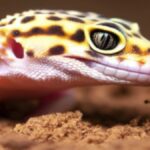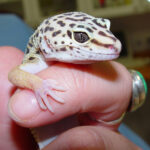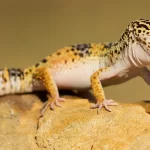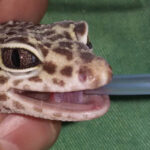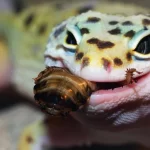Leopard geckos make great pets for beginner and experienced reptile owners alike. These docile lizards are easy to handle, have simple care requirements, and live for up to 20 years with proper husbandry. A key aspect of keeping leopard geckos healthy and happy is setting up an appropriate habitat. In this article we talk about Leopard Gecko Habitats Effective Disinfection Techniques.
An ideal leopard gecko enclosure allows your pet to thrive in a stress-free environment. This article will teach you how to design a suitable leopard gecko habitat, including recommendations for tank size, substrate, heating and lighting, hides/decor, and other essential elements. Additionally, you’ll learn effective techniques for cleaning and disinfecting your gecko’s home to prevent disease.
Tank Size
Leopard geckos are terrestrial lizards that need adequate floor space. An adult should have a minimum tank size of 20 gallons long (30” x 12” x 12”). Juveniles can start in a 10-gallon tank. Always opt for the largest enclosure possible, as more room allows for a proper temperature gradient and more decor/hiding opportunities. Glass tanks with screen tops are best. Make sure the lid is escape-proof.
Substrate
Loose substrates like sand, calcium carbonate, or crushed walnut shells can cause impaction if ingested. Instead, use reptile carpet, paper towels, non-adhesive shelf liner, or slate tile. These options are easy to clean, non-toxic, and prevent bacteria growth. If you prefer a natural look, use sterile soil or coconut fiber substrates. Avoid cedar, pine, and corn cob beddings.
Heating & Lighting
Leopard geckos are cold-blooded, so they require supplemental heat to maintain their body temperature. Use an under tank heating mat on one side of the tank to create a warm spot of 88-92° F. This will allow your gecko to thermoregulate by moving between warm and cool areas. The cool end should be around 75-80°.
In addition to heat, leopard geckos need appropriate lighting. Provide UVB light on a 12 hour on/off cycle to mimic daylight. This allows them to produce Vitamin D3 for healthy bones. Avoid nocturnal red/blue bulbs.
Hides & Decor
Leopard geckos feel secure with an abundance of hiding spots. Provide a minimum of one warm and one cool humid hide, along with additional decor. Use hollow logs, cork bark, artificial foliage, etc. Keep the number of accessories reasonable to allow open space.
Cleaning & Disinfection
With proper husbandry, cleaning is fairly straightforward. Spot clean waste daily. Every 1-2 months, remove all accessories and substrate to clean and disinfect the tank and decor. Here are some effective disinfection tips:
– Use a 3% bleach solution for 10 minutes before rinsing thoroughly. Vinegar also works.
– Quaternary ammonium compounds make excellent reptile-safe disinfectants.
– Let all items dry completely before reassembling the habitat.
– Replace substrate completely every 4-6 months.
– Wash hides, dishes, etc. with soap and hot water monthly.
Avoid strong chemicals or fumes that could irritate your gecko’s lungs. Rinse all disinfectants thoroughly. Also replace any accessories that are too soiled. By following these steps, you’ll eliminate dangerous microbes without harming your pet.
Additional Care Tips
Proper nutrition, limited handling, and routine vet checkups will also keep your leopard gecko healthy for years to come. Feed them live insects along with powder supplements. Give them time to settle in before attempting to handle them. And be vigilant for signs of illness so you can seek veterinary care promptly.
If you notice decreased appetite, weight loss, abnormal feces/urates, skin issues, respiratory problems, or other changes, isolate the gecko and schedule a vet exam right away. Catching issues early makes treatment easier.
By constructing the ideal habitat and providing attentive care, your leopard gecko can thrive for their full lifespan of 15-20 years or more! Do ample research before bringing one home, and properly outfit their enclosure ahead of time. Meet their basic needs of heating/lighting, tank size, substrate, and hides. Stay on top of cleaning/disinfection to prevent infectious diseases. With the right environment and care, leopard geckos make delightful pets. I sincerely hope you find this “Leopard Gecko Habitats Effective Disinfection Techniques” article hlepful.


